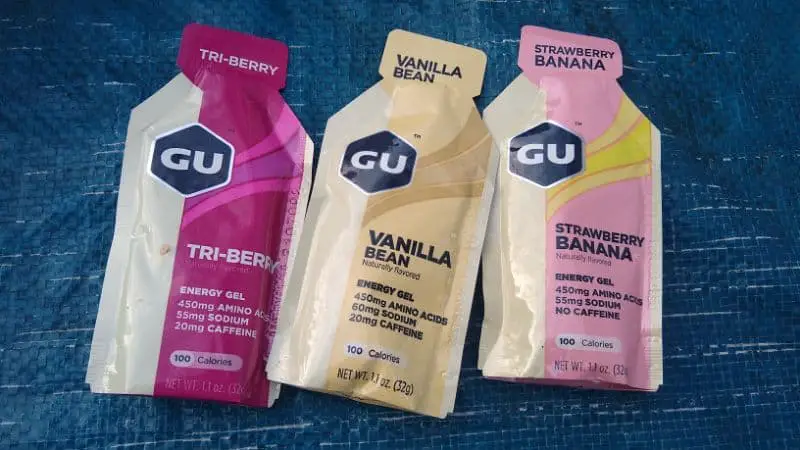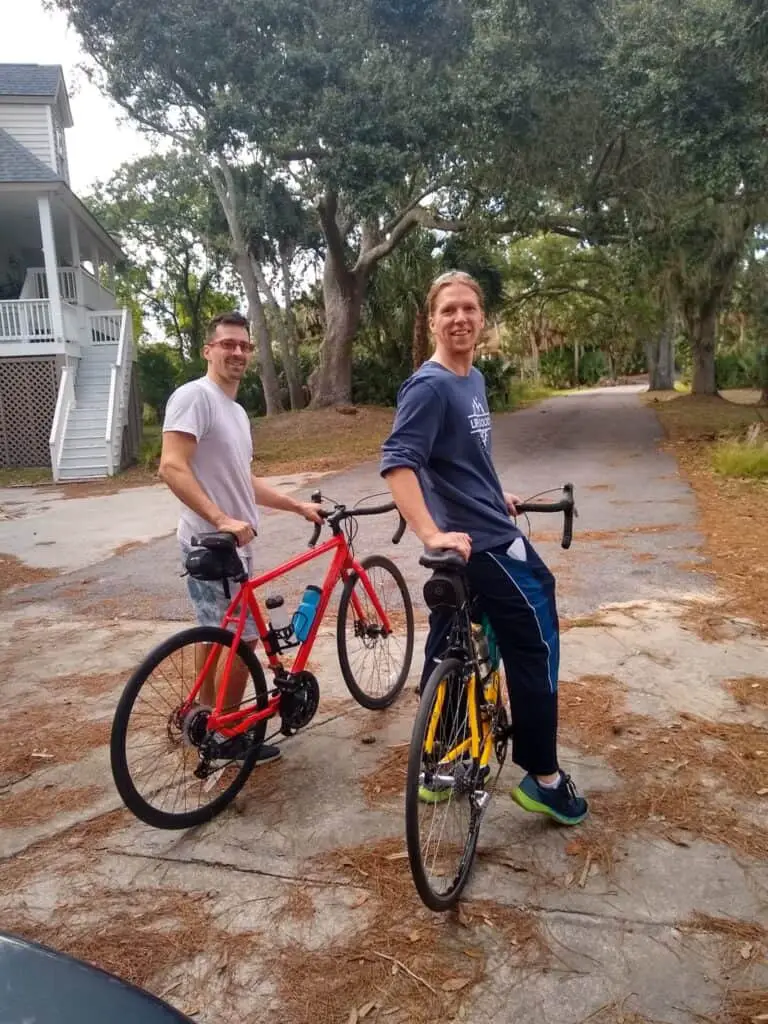
Meet the Guide!
Andy is a jack-of-all-adventures, master of none. Depending on the season, you might find him rock climbing, trail running, kayaking, skiing, mountain biking, surfing or good ol’ hiking.

Gear Guide Introduction
Who This Guide Is For:
This Gear List is for recreational endurance athletes attempting their first endurance triathlon (Olympic, 70.3, and Ironman) races. It’s for people who are determined to finish strong, not necessarily to win.
What worried me most the night before my race wasn’t the race itself. I knew I could make it 70.3 miles. No, I was worried I had forgotten something.
I even had nightmares. What if I had a flat tire – but forgot my tire levers? What if I came to T2 – but had no safety pin? Would I have to run 13.1 miles carrying a piece of flapping paper in my hand? Would I have to go beg fellow athletes for a spare safety pin, a piece of chewing gum, a pine needle, anything??!
Packing gear for a triathlon race isn’t easy. Here’s a list to help you.
And best of all, how to pack for an Iroman – on a budget.
Who This Guide Is NOT For:
- If you’re an aspiring professional endurance athlete, get outta here! Take your $5,000 carbon fiber bikes elsewhere.
- Not to put too fine a point on it, but if you’re looking to crush the competition and claim eternal glory, then might I humbly suggest you look elsewhere? You won’t find any tricks here on how to attach your bike cleats with rubber bands to your clipless pedals for a quick getaway.
- This guide is not a full instruction manual on how to train for and complete an endurance race.
Visual Inspiration

Activity Demonstration

Safety & Risk
What Are the Dangers of Racing a Triathlon?
An Ironman doesn’t carry quite the risk of death, as, say, bungee jumping. But endurance athletic events can seriously mess you up through overtraining. Remember to taper off at least a week before your Big Day!
Bikes can crash; ankles can twist; waves can drown. But it’s pretty safe. There are safety kayaks and jet skis constantly patrolling the swim. There are aid and nutrition stations every mile during the run, and volunteer personnel throughout the bike course.
But since I’m a morbid person, I did some research. Turns out, dying in an Ironman is extraordinarily rare, but it has happened. Seems like most fatalities come from drowning during the swim and cardiac events while cycling.
But the worst story was Brian Godlove, who finished an Ironman 140.6 and died three days later from muscle tissue breakdown.
Don’t overdo it, folks! You don’t rise to your expectations; you fall to the level of your training.
- Don't overtrain! Rest = success!
- Swim carefully, especially at the start.
- Stay hydrated. Drink like you're a manatee.
What Is an Ironman Triathlon?
An Ironman is a 140.6-mile ultra-endurance triathlon race: swim, bike, run.
- 2.4-mile swim
- 112-mile bike
- 26.2-mile run
(Technically, “Ironman” is just a brand name for a company that sponsors some of these triathlons. In the U.S, the USA Triathlon (USAT) Group actually sponsors most of the races.)
Besides the full-distance ironman, other endurance triathlon distances include:
Triathlon Race Distances
| NAME | SWIM | BIKE | RUN |
|---|---|---|---|
| Olympic | 1.5 km (0.93 mi) | 40 km (24.85 mi) | 10 km (6.21 mi) |
| Half (70.3) | 1.2 mi (1.9 km) | 56 mi (90 km) | 13.1 mi (21.1 km) |
| Full (Ironman) | 2.4 mi (3.8 km) | 112 mi (180 km) | 26.2 mi (42.2 km) |
If you’re wondering, “Why on earth would any lunatic sign up for this?” then I invite you to browse some less painful adventures.
But if losing your social life to daily training only to suffer through several hours of mental agony sound like your thing, then welcome to the crazy world of ultra-endurance sports.
I ran an Ironman 70.3 myself, which I described in this Know Before You Go guide. This Gear Guide is all about the gear, which is arguably the “fourth leg” of a triathlon!
Purchasing Gear List for an Ironman Triathlon
Gear List for an Ironman Triathlon
I’ve dabbled in a lot of adventure sports, and I’ve never come across gear junkies like triathletes. These guys will drop more money on a race than I’d pay for a brand new car.
I think I read once that the average Ironman finisher has an annual income of somewhere around $220,000. So that puts things in perspective.
Even if you do make a quarter-million dollars a year, maybe you’d rather spend it on something besides toys that gather dust most of the season.
The Gear List below assumes you are a reasonable person with an average budget. You want gear that is trustworthy without breaking the bank. You want to buy gear that is multi-sport compatible, not exclusively for triathlon races.
Including my bike, I spent about $720 on Ironman gear. That’s a tiny fraction of what most people pay. Some people spend that much on a trip computer, for Pete’s sake. And most of what I purchased, I bought new.
Anything labeled for triathletes seems to cost twice as much as the generic equivalent. I avoid brand-name stuff like the plague. Remember the rule of diminishing marginal returns: Beyond a certain threshold, the more you spend, the less you get.
Was my $25 Schwinn bike helmet quite as aerodynamic as the other guy’s $300 Giro Aerohead? I’m sure it wasn’t. Then again, his thighs looked like he stuffed two turkeys down his pants, so I doubt his helmet on my head would have made much of a difference in our rankings.
| ITEM | REQUIRED? | COST | NOTES |
|---|---|---|---|
| SWIM | |||
| Wetsuit/Swimsuit | Mandatory | $50 - $300 | See Gear Notes |
| 2x Goggles | Required | $15, Ea | One primary, one spare. One clear, one tinted. |
| Anti-Fog Spray | Recommended | $10, Bottle | |
| Swim Cap (Personal) | (Optional) | $5 | Make sure it goes over your ears! |
| Swim Cap (Race) | Mandatory | Provided | Don’t lose it! |
| Nose Clip | Optional | $7 | Bring a spare; most don’t float. |
| Ear Plug | Optional | $4 | |
| Waist Pack | Optional | $20 (Sometimes Provided) | Super useful for eyeglasses, nutrition gels, etc. Can be worn during swim! |
| Flip Flops | For wussies | $5 | Walking to the swim start. |
| Absorbent Towel | Recommended | $5 | Drying off after swim. |
| Swimmer’s Snorkel w/ Purge Valve | Sometimes Optional (also for wussies, but I did wear one) | $30 | Allowed in USAT triathlons, but not in Ironman races! |
| BIKE | |||
| Tri Suit/Race Clothing | Mandatory | $50 - $300 | See Gear Notes |
| Race Road Bike | Mandatory | $400 - $2,000 | See Gear Notes |
| Bike Seat Bag | Recommended | $25 | Get the Large size! |
| Bike Mini Pump | Recommended | $25 | Lezyne is best! |
| 2x Spare Tire | Recommended | $10 | See Gear Notes |
| Valve Adapters | Recommended | $2 | Presta-to-Schrader, most likely. |
| 2x Tire Levers | Recommended | $2 | Know how to use them! |
| 2x Tire Patches | Recommended | $2 | For pinch flat emergencies. |
| Bike Multi-Tool | Recommended | $20 | |
| Helmet | Mandatory | $30 | |
| Bike Shoes | Nah | $120 | Are they really necessary? See Gear Notes. |
| Sunglasses | Recommended | $20 | If not sunglasses, then visor. |
| Sunscreen | Optional | $4 | Cancer if you do, cancer if you don’t! |
| 3x Water Bottles | Recommended | $7 | You must get SQUEEZE bottles! |
| Headlamp | Optional | $25 | If you’ll be biking/running in the dark |
| Trip Computer/Watch | Meh | $20 - $1000 | Are they really necessary? See Gear Notes. |
| Helium Balloon? | Optional | $3 | See footnotes |
| RUN | |||
| Running Shoes | Mandatory | $75 | See Gear Notes |
| Socks | Recommended | $10 | Quarter-length athletic socks. |
| Headband | Optional | $3 | Keeps sweat out of your eyes. |
| Spare Safety Pins | Don’t forget ‘em! | $1 | Always have a backup. |
| OTHER | |||
| Lube | Mandatory | $10 | See Gear Notes! |
| Gallon Ziploc bags | Recommended | $4 | For gear organization |
| Nutrition | Required | $50 (gels) | See Gear Notes |
| Hydration | Required | $15 (sports drinks) | See Gear Notes |
Gear List Explanations & Footnotes
Footnotes
Helium balloon: I heard about this genius idea somewhere online. If you’re competing in a massive race, then go buy a $2 helium birthday balloon from Dollar General and attach it to your bike. You’ll easily find your bike by looking for the creepy clown on a pink heart balloon!
What’s Not On This List
You know what’s not on this list? Pre- and post-race clothing. You’re a big kid. I’m not going to tell you what to wear before the race or after the race. If you want to wear flip-flops to the swim start, you do you.
Also not on this list: A $25 race belt. I could buy three good Angus burgers for $25. If you’re worried about the 18 seconds it takes to pin on a race number will ruin your race day, then I humbly suggest you’re reading the wrong article. May I suggest the Iron Cowboy?
Also not present: Dedicated transition bags. No shame in a Hefty garbage bag, my friend. Blue-collar and proud!
Maybe this should be on the list: Altoids. If you’re swimming in the ocean, Altoids get rid of that nasty saltwater mouthfeel.
Also not listed: Recovery and rehabilitation items. If you want to bring ice packs, foam rollers, yoga mats and healing crystals, more power to you. Bring whatever you need to heal safely. Personally, I heal best with a Pizza Hut large pepperoni and a Mr. Pibb.
Lastly, I don’t mention a timing chip because one is provided for you. But don’t lose it! Otherwise, it’s an automatic DQ. And you’ll own them money. Which is against the premise of this entire article.
Triathlon Transition Bags Packing List
Transition Bags Gear Lists


Morning Bag Packing List
- Wetsuit
- Goggles
- Earplugs, nose clip, etc.
- Race swim cap
- Timing chip!
- Pre-race nutrition
- Medication
- Lubricant
There’s no bag drop off at the swim start! Anything you bring has to fit in your waist pack or inside your wet suit.
T1 Bag Packing List
- Tote bag (often provided)
- Helmet
- Clean water for washing feet
- Hand towel for drying feet
- More lubricant
- Pre-bike and bike ride nutrition
- Sunscreen
- Sunglasses
- Headband or cap
- Watch/computer
- Shoes and socks
- Bike clothing, if not wearing tri suit
- Altoids!
Ttire patch kit, spare tubes, mini pump, etc. should already be stored within your saddlebag and mounted on your bike! So should your 2x squeeze water bottles.
T2 Bag Packing List
- A reward: Candy, chocolate, an apple, donut, picture of your favorite celebrity, whatever you want. Pamper yourself.
- Tote bag (often provided)
- Running shoes and socks (if changing)
- Running clothing (if changing)
- Race number bib! DO NOT FORGET!
- Safety pins or race number belt
- Nutrition and electrolytes
- Sunscreen
- MORE LUBRICANT!
Gear Advice
Trip Computer/Watch
This really is completely your preference. I don’t like ‘em. When I wear one, I can’t focus on the race; I just focus on my time.
But for my race, I folded under peer pressure, so I bought a $20 Casio sport watch – and then I forgot to look at it for the entire race.
So do what you want: $20 Casio, $100 FitBit, or $600 Garmin. Or nothing at all. Just focus on passing up the guy in front of you. Imagine he cheated with your girlfriend and stole your job promotion, whatever it takes.
Goggles
I’m not a professional swimmer. My experience with swimming goggles is limited to just three brands.
I do have awful eyesight, though. I bought the Aegend goggles off Amazon, and guys, for $15, you basically get a pair of prescription swimming goggles!
Many Amazon viewers complain that things look fuzzy underwater, but just as many complain that the goggles magically improved their eyesight. If you’re nearsighted, like me, then apparently the Aegend goggles partially correct your vision underwater!
All the anti-fog coatings eventually wear off, so bring your own anti-fog spray. Apply it BEFORE you get to the swim start.
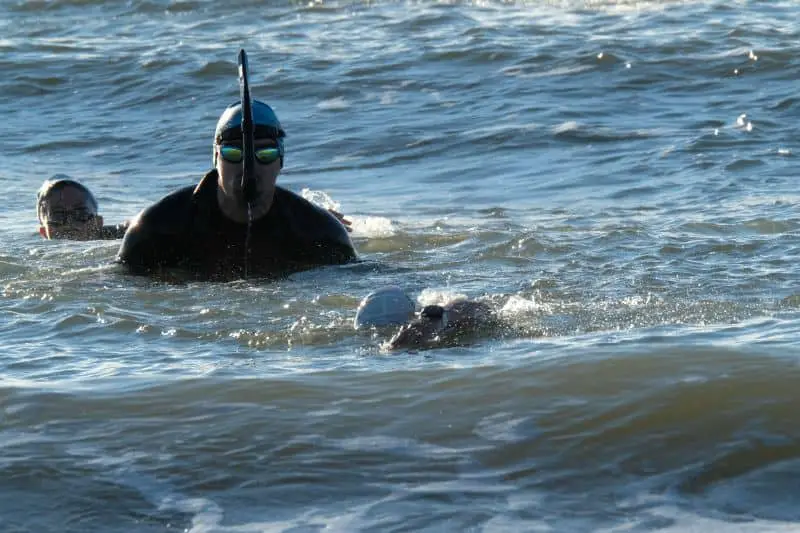
Wetsuit
If your race is wetsuit legal, a 2mm or 3/2mm wetsuit will provide buoyancy, keep you warm, and make side breathing easier. Don’t go thicker than 3mm, or it will restrict your shoulder mobility.
You can buy used wetsuits on Ebay for a song and a dance, often in great condition. People tend to grow out of their wetsuits (old age comes fast!), which is a great opportunity for good deals!
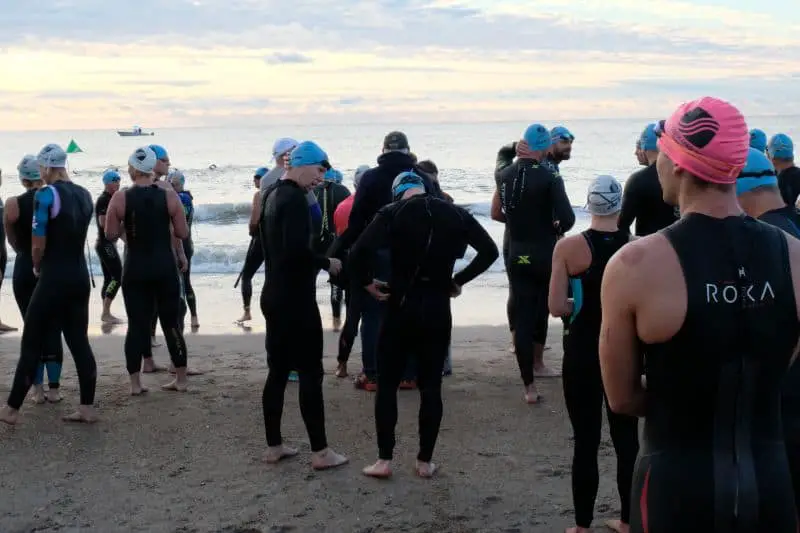
Tri Suit
I’m firmly in the never-buying-a-tri-suit camp. It breaks my rule: Never buy anything I’ll only use once (or two or three times, but you get the idea).
If you prefer a tri suit, pick up a used one online. It’s crazy what retailers charge for these spandex onesies.
I ran my Ironman 70.3 in $20 black compression shorts and a $20 cycling jersey, and they were perfect. I wore the compression shorts underneath my wetsuit and packed the jersey in my T1 Transition Bag.
Can’t recommend the cycling jersey enough. It had an elastic waistband, a zipper front, and three pockets along the back that were perfect for storing energy gels. Plus, in pictures of the vent, I actually looked like an athlete and not a second-rate Marvel superhero.
And best of all, I still wear that gear to this day.
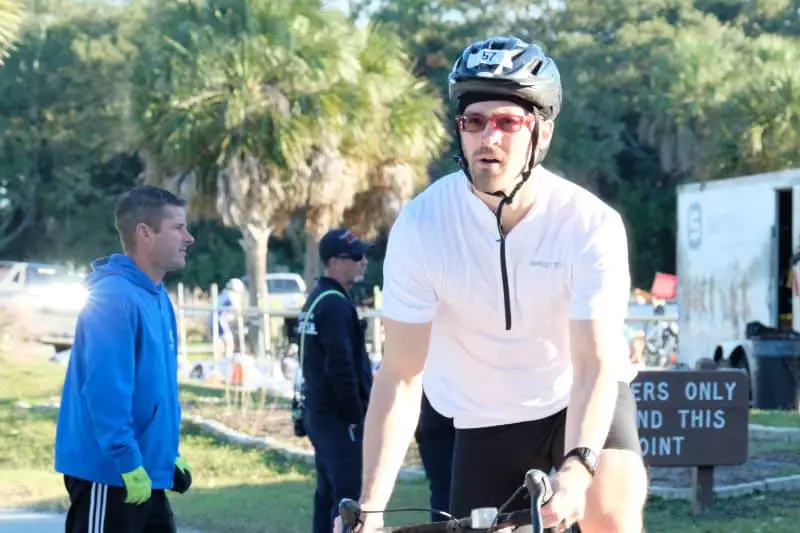
Bike (aka, Your Noble Steed)
Ignore all the balderdash about sport-specific bikes. You don’t need a carbon-fiber frame, aero bars, aero wheels, and all that nonsense.
I hate to break it to you, but as a non-elite endurance athlete, it’s much more likely your muscular stamina and mental fortitude, not your aerodynamics, will limit your performance on race day.
But you also don’t want to cycle a hundred miles on a mountain bike. That’s a VIP ticket to the hurt locker. I’ve done it.
Thankfully, almost any road bike or touring bike can be adapted reasonably well to Ironman racing. Best to buy gently used. If you’re buying new, BikesDirect.com has a notorious reputation, but it really is the best bargain I’ve ever found. You gotta be an amateur mechanic, though – I’ve always found something wrong!
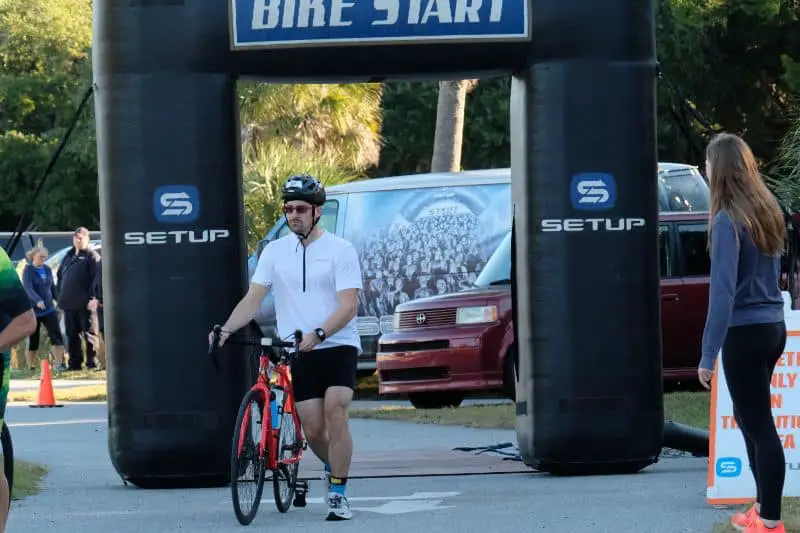
Lube
This could be the #1 most important entry on this list. (I’ve run 9 miles in a wet swimsuit, so I know what I’m talking about. Worst idea of my life).
If you’re cheap, like me, just bring along some petroleum jelly. Stuff works like a charm. If you’re concerned about staining your $200 tri suit, then you can use something like Body Glide anti-chafe cream or Chamois Butt’r.
Apply lubricant to:
- Shoulders, hips, ankles, wrists and lower neck before swim.
- Between legs, on chest and on yer rump before bike.
- Between legs and on chest before run.
Running Shoes
I advocate wearing a single pair of shoes for both the bike and the run.
(I don’t advocate following my exact strategy, which was purchasing a $60 pair of Asics online, realizing I needed width Size E, running frantically to Walmart five days before the race, and buying an $18 pair of New Balance running shoes.)
Any decent pair of running shoes (preferably close to new!) will work for a race. Break them in for at least 25 miles before race day. Fit is much more important than brand. I literally tried one every. single. shoe. in the Walmart aisle before I found one that really fit my foot.
Don’t be snooty, but be choosy!

Bike Cycling Shoes
Guess what? I didn’t wear bike shoes!
I’ve cycled over 20,000 miles in my life, and I have to admit: I don’t think bike shoes make much of a difference. And the science (mostly) bears that out. Stiff bike shoes with rigid soles only matter for all-out sprints. In endurance riding, there’s very little efficiency benefit. Your technique matters much more than your shoes ever will!
What really wastes energy, though, is having your feet slide around the pedals. So I spent $10 on plastic toe cages, which fasten to your bike pedals with machine screws. Couldn’t be easier. And when other cyclists, locked into their pedals, were falling off their bikes on 180-degree U-turns, I could put down a foot to stabilize – and then pass ‘em up!
If you are determined to wear cycling shoes, you can choose SPD (mountain bike) or Delta (spin bike) cleats. Your call. You’ll need compatible pedals as well.

Bike Components
Handlebars
At a minimum, get some drop handlebars – and practice with them! If you’re not used to drop handlebars, you’ll get one helluva kink in your neck on race day.
There’s also nothing wrong with aero bars, and they do work! – but you’ll only use them on races. They’re no good for regular road cycling or touring.
Saddle
It’s much better to pad your saddle than pad your bum, in my opinion. I wore compression shorts with zero padding. Took 3-4 long-distance rides to get used to it, but then the soreness was gone.
Handle Grips
Use comfortable handle grips. Hard grips can stop all blood flow to your hands after an hour or two of riding.
Tires
Of all the components on your bike, handlebars and tires are the two places worth spending some money on.
There’s nowhere you want to shave weight more than your tires. You need something lightweight, slick, and fast. I bought 25mm Continental Ultra Sport III Race Tires to replace my Kenda 38mm gravel touring tires. Worked like a charm and cost about $50 for the pair.
Get some 25mm or 28mm foldable 700c tires. Don’t pump them up to max capacity the first time! Inflate to 50%, wait a few hours, inflate to 75%, wait a few hours, and then inflate to maximum pressure.
I did not bring a spare foldable tire. If my tire shredded during the race, I was just going to ride a naked rim all the way to the finish line. I looked it up, and yes, it’s legal.
Tubes
I’m of the opinion to save weight on tires, not tubes. There’s nothing more demoralizing than training for your Big Day for six months only to pop a paper-thin tube on Mile 47!
Avoid self-sealing tubes, since they are extremely heavy! But don’t spend the big bucks for super thin “racing tubes” either. Get something reliable. An ounce or two extra won’t matter much.
You might be saying to yourself, “Don’t need tubes. I run tubeless tires and rims.”
Nothing wrong with tubeless tires. So long as they don’t go flat, they’re definitely better for races. However, if tubeless tires get punctured, replacing them is an absolute bear. Be warned!

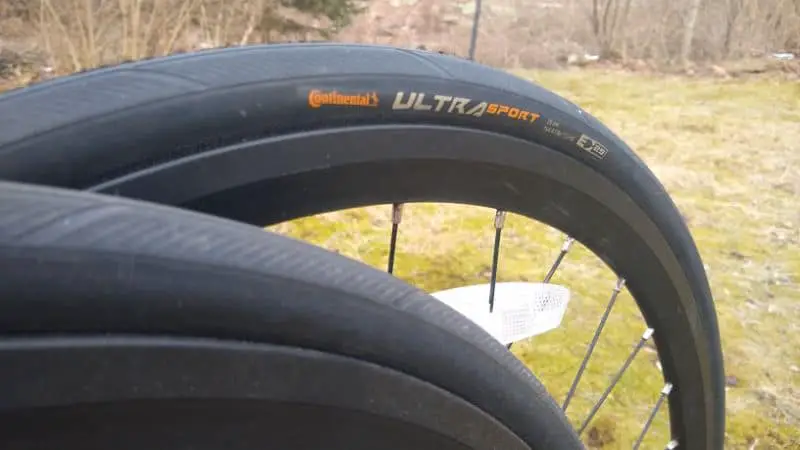

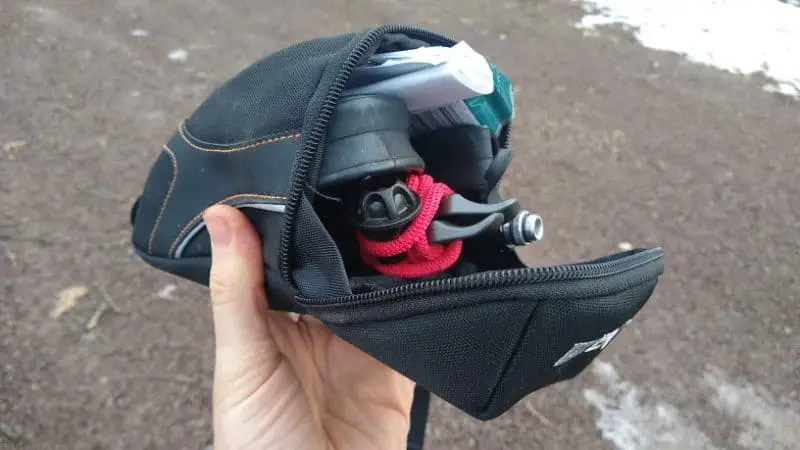
Nutrition
Every Ironman athlete has concocted their own nutritional alchemy.
I’m normally a Clif Bar guy, but I switched to GU Energy Gels (a competitor to Hammer Gels) for the race. Gels are quicker to digest and easier on your stomach. Plus, gels pack up easily in your jersey pockets, bike saddle bags, waist packs, etc.
Gels are not the cheapest opinion. But coming from a guy who once spent three days eating nothing but chia seed energy bars … energy gels are worth spending money on.
But as I said, you do you. I ran the race with my brother, and he packed a full-on sandwich for the start of the half marathon. Right about then, I thought he was a genius. I’d eaten nothing but energy gels for nine hours, and he was enjoying a homecooked meal.
Stay away from soda unless you’re in the second half of the run, and you’re craving carbohydrate energy more than you’re craving hydration. Personally, I preferred drinking Gatorade over water during the race. Gotta replenish those electrolytes!
